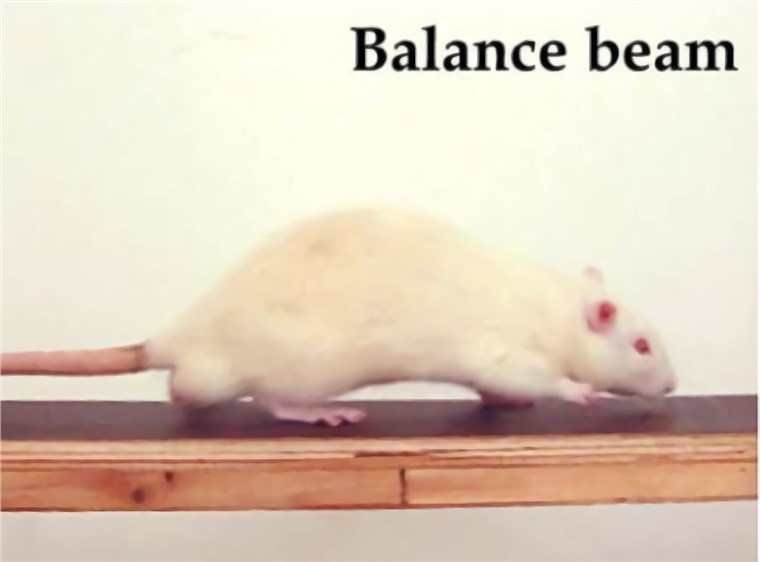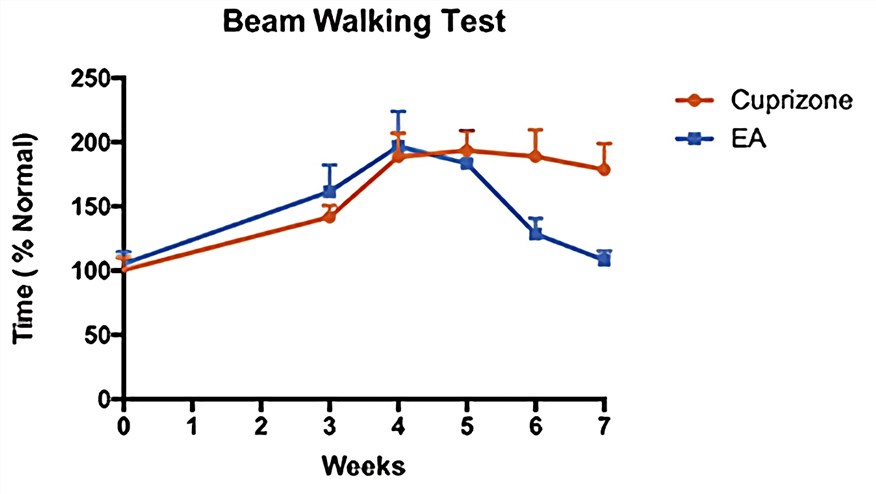Beam Walking Test
A broad variety of rodent motor tests are available to determine deficits in animal models. The ‘beam walking test' or ‘balance beam test' is used to analyze rodent gait in a testing environment that challenges their ability to maintain balance given that the animals have to cross an elevated beam with a narrow diameter. Here, Creative Biolabs conducts the beam walking test to analyze gait-related behavior and deviations in limb coordination of rodents.
Introduction of Beam Walking Test
 Fig.1 Beam walking test. (Feng et al. 2014)1,3
Fig.1 Beam walking test. (Feng et al. 2014)1,3
This test is used for the assessment of motor coordination, particularly of the hindlimb. Firstly, animals are placed in one corner of the narrow beam and allowed to walk across the narrow beam from one end to the other for at least three times. The narrow beam measures 1-3 cm wide and is elevated between a pole and their home cage (to attract the rat to the finish point). This training step can be useful to achieve a stable baseline measurement. The number of foot slips encountered, and time taken to cross the beam in each trial are recorded.
If animals hesitate to cross the beam, walking can be stimulated by tapping on the tail. However, this must be performed in all animals to keep testing sessions comparable. What's more, a ledge can be installed next to the narrow beam to be used as a crutch, on which the impaired limb can be placed. With this system in place, healthy animals can then traverse the beam without additional support, whereas animals with impaired fore- or hindlimb function frequently step on the ledge as a support.
Features of Beam Walking Test
- The beam walking test requires minimal equipment and can be conducted quickly, given that one run should not exceed 60 seconds.
- The beam walking test has been used in rodents to measure impairments after both TBI and stroke.
- However, scoring occurs during the test period, which makes results prone to 33 subjective influences by the observer. This may be minimized by filming the test sessions and having two blinded observers score the animals.
 Fig.2 Electroacupuncture (EA) treatment significantly reduced the time spent in beam walking test. (Deng et al. 2015)2, 3
Fig.2 Electroacupuncture (EA) treatment significantly reduced the time spent in beam walking test. (Deng et al. 2015)2, 3
Creative Biolabs also conducts other behavioral tests for motor function assessment:
Creative Biolabs provides highly customized behavioral tests to suit specific scientific needs. Moreover, new behavioral tests of motor function are developed and validated.
As an undisputed specialist in neurological disease drug development, Creative Biolabs has an extensive range of rodent neurological disease models, which are widely used for drug efficacy studies combined with different behavioral tests. If you are interested, click the links for more detailed description.
For more information, please contact us or send us an inquiry.
References
- Deng, W.; Gage, F. H. The effect of immature adult-born dentate granule cells on hyponeophagial behavior is related to their roles in learning and memory[J]. Frontiers in Systems Neuroscience. 2015, 9(9):34.
- Feng, Q.; et al. Specific reactions of different striatal neuron types in morphology induced by quinolinic acid in rats[J]. Plos One. 2014, 9(3): e91512.
- under Open Access license CC BY 4.0, without modification.
For Research Use Only.
